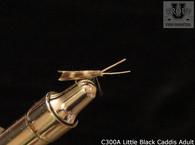We had the privilege of taking the Davidson Day School children up to the Marion Coldwater Hatchery Tuesd ay September 29 to participate in the Trout in the Classroom Project sponsored by Rocky River Trout Unlimited Chapter. Marion Coldwater Hatchery is, of course, a coldwater trout hatchery consisting of four earthen ponds, eight concrete spillways, a hatchery building with indoor rearing tanks, and a spring-fed water-supply pond, which has no fish in it.
ay September 29 to participate in the Trout in the Classroom Project sponsored by Rocky River Trout Unlimited Chapter. Marion Coldwater Hatchery is, of course, a coldwater trout hatchery consisting of four earthen ponds, eight concrete spillways, a hatchery building with indoor rearing tanks, and a spring-fed water-supply pond, which has no fish in it.
It is the desire of the biologist that the pond remain fish free to lessen the chances of getting a diseased fish in the pond. A diseased fish would spread unwanted pathogen to the rest of the fish in the facility.

Dave Deaton from the North Carolina Wildlife Commission gave the students a tour including the ponds. He went on to explain to the students that the hatchery needs 3 C water (clean, clear, and cold). Since the facility is supplied with spring water, it meets the 3C objectives.
The students were told that the rainbow trout eggs were taken from the Erwin Tennessee hatchery and transported to the Marion Coldwater Hatchery in Styrofoam containers. These containers have trays with holes in them. The eggs are laid on the shelves with paper towels to absorb the water that is released when the ice melts. These containers are so efficient that the eggs could be shipped
to California in them.

When the eggs arrive they are placed in incubators where flowing water provides oxygen to the developing trout for two to six weeks until hatching. Newly hatched trout, called "sac fry," are placed in troughs inside the hatchery building. The water for the hatchery is provided by a spring and it maintains an average temperature of 55 degrees for the entire year.
The hatchery starts with about 220,000 eggs each year to hatch and become fingerlings. The fingerlings will grow about one inch per month until they are at the stockable size of approximately 10 inches one year later. Of the 220,000 eggs to start, only about 100.000 will survive to become stockable.
 ay September 29 to participate in the Trout in the Classroom Project sponsored by Rocky River Trout Unlimited Chapter. Marion Coldwater Hatchery is, of course, a coldwater trout hatchery consisting of four earthen ponds, eight concrete spillways, a hatchery building with indoor rearing tanks, and a spring-fed water-supply pond, which has no fish in it.
ay September 29 to participate in the Trout in the Classroom Project sponsored by Rocky River Trout Unlimited Chapter. Marion Coldwater Hatchery is, of course, a coldwater trout hatchery consisting of four earthen ponds, eight concrete spillways, a hatchery building with indoor rearing tanks, and a spring-fed water-supply pond, which has no fish in it. 






